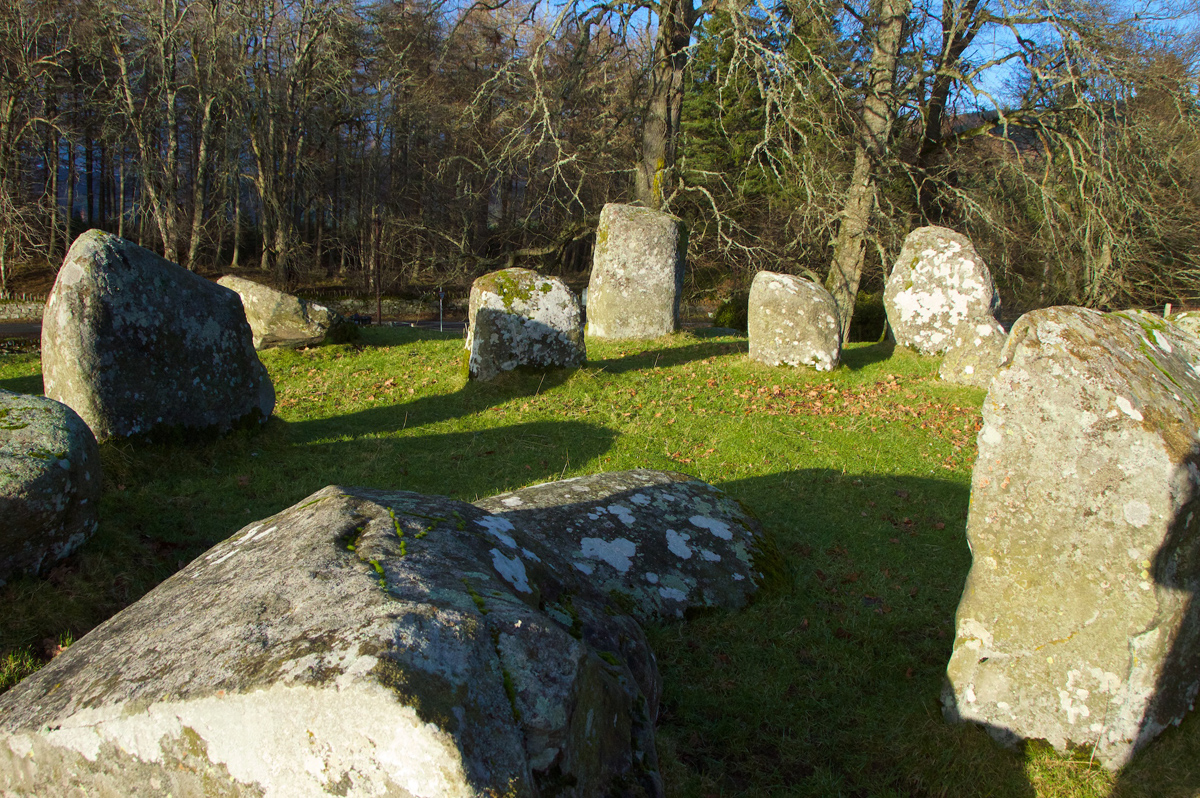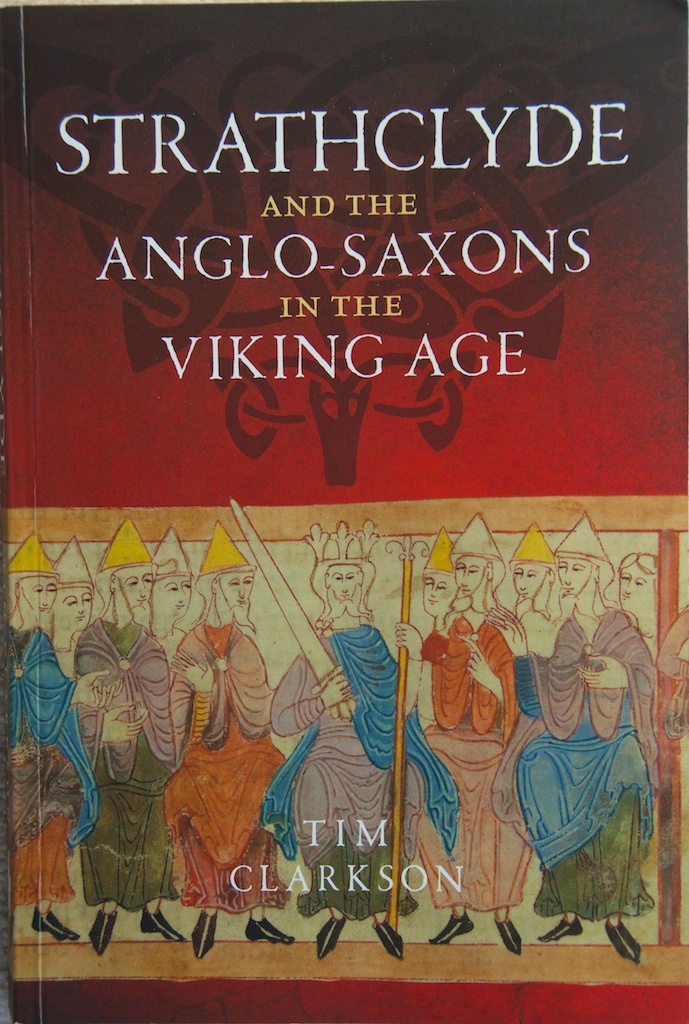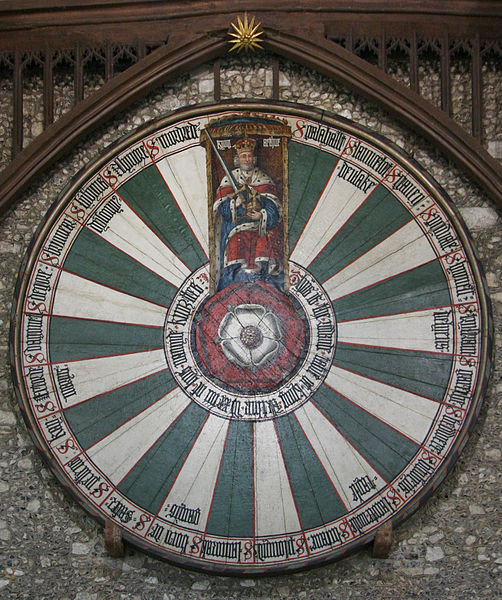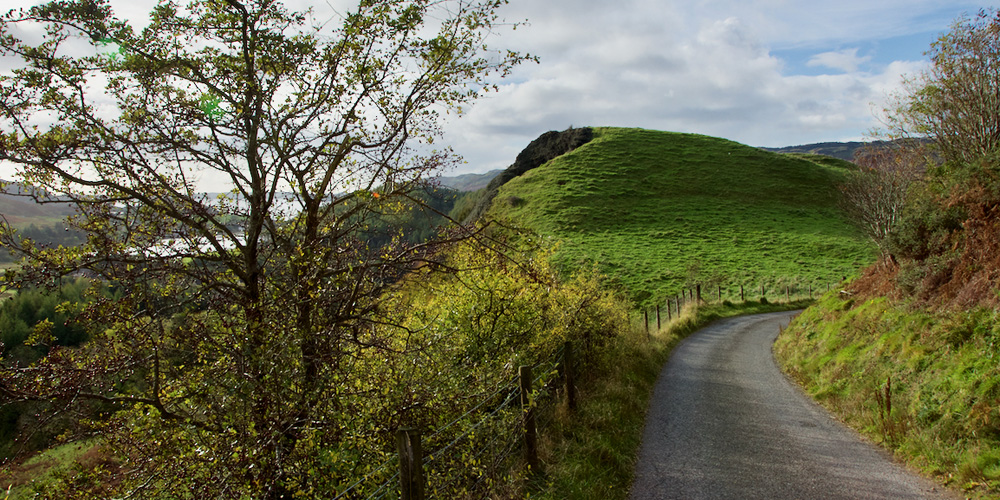
Croft Moraig: circle of light
 The stones of Croft Moraig stand right by the side of the main road from Kenmore to Aberfeldy; in fact, they’re so close that you can easily miss them!
The stones of Croft Moraig stand right by the side of the main road from Kenmore to Aberfeldy; in fact, they’re so close that you can easily miss them!
Hiking for miles across bleak moorland to a remote stone circle might have its romantic appeal, but on a cold January day with the sun already low in the sky by early afternoon there is something to be said for lifting the latch of a roadside gate and strolling about fifty yards into a field.
 And these stones are absolutely beautiful – there is such a lovely quality about them, and it wasn’t all down to the light. Quite a compact group, they sit on a man-made platform of earth, slightly raised above the level of the surrounding field. The tallest one is about shoulder-high (to me, anyway) and a number of them have fallen; some of them are curiously lined – glacial striations, perhaps – and some of them bear cup markings.
And these stones are absolutely beautiful – there is such a lovely quality about them, and it wasn’t all down to the light. Quite a compact group, they sit on a man-made platform of earth, slightly raised above the level of the surrounding field. The tallest one is about shoulder-high (to me, anyway) and a number of them have fallen; some of them are curiously lined – glacial striations, perhaps – and some of them bear cup markings.
When you first approach the site, it’s not immediately obvious what pattern the stones make on the ground, and this is because there is more than one circle, one inside the other, each dating from different periods of time. When it was excavated in 1965 by Stuart Piggott and Derek Simpson, Croft Moraig (which means ‘Mary’s Croft’, and is a much more recent name) was revealed to be quite a complex setting – and in fact it is the best preserved monument of its kind in Scotland.
 Nothing remains of the very first structure which stood here, a horseshoe-shaped ring of 14 upright timbers, with an opening to the south. They were put up around 3000 BC, and a shallow ditch was dug around them. Archaeologists don’t know if the posts belonged to a building, in which case they would have helped to support walls of some kind, or whether they stood alone, linked by horizontal posts laid across the top in the manner of Stonehenge.
Nothing remains of the very first structure which stood here, a horseshoe-shaped ring of 14 upright timbers, with an opening to the south. They were put up around 3000 BC, and a shallow ditch was dug around them. Archaeologists don’t know if the posts belonged to a building, in which case they would have helped to support walls of some kind, or whether they stood alone, linked by horizontal posts laid across the top in the manner of Stonehenge.
Aubrey Burl has his own theory:
“At Croft Moraig when the uprights weathered, some were replaced more than once and it is tempting to visualise a freestanding timber setting with a central, flat boulder beside a hollow containing burnt bone.” (‘The Stones Circles of the British Isles’)

From studying the pattern of the post holes, which are shown on the information board as small and very faint grey shapes, you can see that there was a short, almost parallel row of posts to the east, which is assumed to have been an entrance.
At a later, unknown date the wooden posts were replaced with stones (shown in darker blue-grey) and these were surrounded by a low rubble bank. Eight stones were arranged in a circle, with the suggestion of an entrance to the south-south-west; one has since fallen over. Three further stones were placed just to the south, and one of these is also recumbent.



Burl says that one of the eight stones (to the north-north-east of the circle) is cupmarked, and so is a smaller stone which lies in the rubble bank, roughly where the ‘entrance‘ would have been. I have to admit that I didn’t see any cupmarks on the northern stone, although I walked around most of them, and to my regret I didn’t inspect the small stone in the bank closely enough.
Beneath some of the stones, archaeologists found “charcoal-laden earth and Neolithic sherds… that came possibly from the first phase.” These sherds were dated by Piggott and Simpson to the turn of the third and second millennia BC.

 In the third wave of construction (shown in the diagram in brown) nine stones were set up on the outside of the first circle and surrounding it completely; two additional stones, large and quite impressive, were placed to the south-east, and these suggest a ceremonial entrance more than any other surviving feature. They may also have marked the site of burials:
In the third wave of construction (shown in the diagram in brown) nine stones were set up on the outside of the first circle and surrounding it completely; two additional stones, large and quite impressive, were placed to the south-east, and these suggest a ceremonial entrance more than any other surviving feature. They may also have marked the site of burials:
“In front of each was an empty hole which may have held an inhumation long since destroyed by the acid soil.”
As usual with places like this, we are grasping at imaginary straws, touching the skin while standing five thousand years away from the heart.




 It seems as if the stones, especially the ‘third phase’ ones, were not deeply embedded in the ground, but rather chosen for their flat bottoms and planted in fairly shallow holes. I was interested to read that handfuls of quartz pebbles were found scattered at various points around the site. Whatever obscure purpose our ancestors might have had for this place, the appeal of white quartz is timeless, and it has long been carried as a good-luck charm. In fact, I have one in my coat pocket…
It seems as if the stones, especially the ‘third phase’ ones, were not deeply embedded in the ground, but rather chosen for their flat bottoms and planted in fairly shallow holes. I was interested to read that handfuls of quartz pebbles were found scattered at various points around the site. Whatever obscure purpose our ancestors might have had for this place, the appeal of white quartz is timeless, and it has long been carried as a good-luck charm. In fact, I have one in my coat pocket…
Aubrey Burl is quite decisive about the site’s importance:
“Croft Moraig is one of the most informative stone circles in the British Isles. Its Neolithic timber ring is one of the earliest known and may have affinities with the tradition that caused east-west lines to be incorporated into many early stone circles… The variety of stone rings in Perthshire and the distribution of monuments along the hillsides down Loch Tay reveals something of the movement of people and of ideas passing along this prehistoric route that reached from Strath Tay through Glen Dochart and down to Loch Lomond and south-west Scotland.”

 What struck me most was the beauty of the stones themselves – they were not so much covered as trimmed with moss and lichen, and contained the same chips of sparkly mica as their fairly close neighbours at Fortingall. I guess, because of their similarity in height to a human, they seemed friendly and personal and it crossed my mind whether some were ‘female’ and others ‘male’. At any rate, they all seemed to be having a very friendly chat with each other, and there was no off-putting ‘keep out’ kind of atmosphere which I have sometimes sensed elsewhere. The fact that all the stones are arranged on a circular platform also gives it a lovely feeling, as if you’re visiting a stage on which the players are frozen in time.
What struck me most was the beauty of the stones themselves – they were not so much covered as trimmed with moss and lichen, and contained the same chips of sparkly mica as their fairly close neighbours at Fortingall. I guess, because of their similarity in height to a human, they seemed friendly and personal and it crossed my mind whether some were ‘female’ and others ‘male’. At any rate, they all seemed to be having a very friendly chat with each other, and there was no off-putting ‘keep out’ kind of atmosphere which I have sometimes sensed elsewhere. The fact that all the stones are arranged on a circular platform also gives it a lovely feeling, as if you’re visiting a stage on which the players are frozen in time.
Perhaps I’m indulging my imagination a bit too much here!
 But there was another thing, and in this observation I know that I have at least one ally to back me up: the trees around the site, which were mainly oaks, were all bending noticeably inwards towards the circle, as if they were eavesdropping on conversations that I couldn’t hear. Just to the south-west, in an adjacent field, stood a huge old oak tree, its trunk looking as if it had grown in a gentle spiral, and its longest and strongest looking branch was inclined towards the stone circle – reaching out towards it, in fact. If there was a ‘guardian’ of Croft Moraig, it felt like this was probably it.
But there was another thing, and in this observation I know that I have at least one ally to back me up: the trees around the site, which were mainly oaks, were all bending noticeably inwards towards the circle, as if they were eavesdropping on conversations that I couldn’t hear. Just to the south-west, in an adjacent field, stood a huge old oak tree, its trunk looking as if it had grown in a gentle spiral, and its longest and strongest looking branch was inclined towards the stone circle – reaching out towards it, in fact. If there was a ‘guardian’ of Croft Moraig, it felt like this was probably it.

 Most of the other stone circles I’ve visited have had no trees growing near them, so I can’t say that I have seen this phenomenon at similar sites. But I have seen trees with amazingly twisted trunks bending themselves into – or away from – ‘tumps‘, man-made mounds or barrows, and now we are back in the beguiling land of Alfred Watkins and ‘The Old Straight Track’. In addition, I have an old book called ‘The Pattern of the Past’ by Guy Underwood, a fascinating man who taught himself the skill of dowsing, and he used it to map the unseen lines of energy around ancient sites. His findings are eye-opening, and for me at least, they were convincing. This is another of my most-cherished books, and if you have an interest in this kind of thing, I think you would love it too.
Most of the other stone circles I’ve visited have had no trees growing near them, so I can’t say that I have seen this phenomenon at similar sites. But I have seen trees with amazingly twisted trunks bending themselves into – or away from – ‘tumps‘, man-made mounds or barrows, and now we are back in the beguiling land of Alfred Watkins and ‘The Old Straight Track’. In addition, I have an old book called ‘The Pattern of the Past’ by Guy Underwood, a fascinating man who taught himself the skill of dowsing, and he used it to map the unseen lines of energy around ancient sites. His findings are eye-opening, and for me at least, they were convincing. This is another of my most-cherished books, and if you have an interest in this kind of thing, I think you would love it too.
At two o’clock the midwinter sun was already sinking behind the hills above Kenmore, casting long fingers of shadow from every single stone of Croft Moraig and giving a golden glow to the mosses that had penetrated the cracks. Just a few hours later, the place would be bathed in light from the nearly-full moon. But the cold was coming down, and a warm car beckoned, and we had a two-hour drive home… so if there were any ancestral spirits stirring under those stones, there was no one to watch them dance.
Sources:
- ‘The Stone Circles of the British Isles’ by Aubrey Burl
- RCAHMS Canmore
- Megalithics.com
- Mysterious Britain and Ireland
- The Megalithic Portal
Photos copyright © Colin & Jo Woolf
Further reading…
 For more megalithic mysteries, take a look at these features:
For more megalithic mysteries, take a look at these features:








32 Comments
davidoakesimages
The number of times I have driven past there…..and missed them! Next time I will have to go with a defined purpose of discovery. They also remind me very much of the Cairns and Circles around Kilmartin, Argyll
Jo Woolf
Yes! We have done the same, it has got to be said. But it is well worth stopping, and you can pull off quite easily. I love Kilmartin – that’s an area that I wouldn’t mind spending days and days exploring, because there’s so much to see. Very special, and an indescribable atmosphere. 🙂
davidoakesimages
Yep….I think it is that ‘atmosphere’ that is so hard to explain to people before they visit. Once they do they know exactly what you mean. Here is a link to one of my archive pages https://davidoakesimages.wordpress.com/2014/01/04/weekly-photo-challengebeginning/
Jo Woolf
Thanks for the link David – fantastic photos! Aaahh, makes me want to go there now! 🙂
Anny
What a superb place – and how it makes my spine tingle. So much we really have no idea about, it really does allow us to try and step into the footsteps of our ancestors. I’m going to seek out the Guy Underwood book.
Jo Woolf
I know, Anny, you would love it too! 🙂 I think you would love that book – it may be out of print (mine’s a 1970s version) but well worth seeking out. Eye-opening and fascinating.
winderjssc
Beautiful pictures of fascinating stones in a lovely setting. Well done.
Jo Woolf
Thank you, Jessica! It was a magical place to explore.
jay reynolds
Fascinating reading & stunning pics, thank you Jo. I must visit next time I come back up home. I’ve read Alfred Watkins’ ‘The Old Straight Track’ & ‘The Pattern of the Past’ by Guy Underwood. both recommended reading. I also have one of Underwood’s strange dowsing gadgets. Tried dowsing the stones for gender ? Could be a pleasant afternoon’s pastime.
Jo Woolf
Thank you, Jay! Glad to find someone else who loves those kind of books. And one of Guy Underwood’s dowsing gadgets?! Did you make it? I would be interested to know what it’s like, and how you have used it! I have never tried dowsing myself but would love to do so. Good idea! 🙂
blosslyn
Lovely photos, interesting about the trees, I wonder if something draws them toward the stones, like a layline type thing 🙂
Jo Woolf
I wonder that too, Lynne. I am convinced that these ancient stone circles and alignments were not just set down at random. I believe that the people who built them had senses and wisdom that we have lost.
christinelaennec
What a beautiful and compelling place, and post. I’d never heard of this spot. Yet another destination to add to my list! On your recommendation, I read The Long Straight Track and found it very interesting. Even living in the city, I now see things (such as a particular notch in the hills beyond) a bit differently! I will definitely explore Guy Underwood. Dowsing is fascinating – it does seem to work, no matter who does it and whether they are predisposed to believe that it words or not. I bought a pair of dowsing rods and did some dowsing in the garden with my mother, who was so amazed by how they consistently pointed to sources of water when held lightly in her hands, that I gave them to her.
Jo Woolf
Hi Christine, I am very glad to hear you enjoyed Alfred Watkins! I remember looking at the landscape in a totally new light myself, afterwards. It’s amazing. I’m fascinated by your report about the dowsing, I am going to have to try it! Guy Underwood produced detailed diagrams of the energy lines surrounding stone circles and barrows, and he detected different kinds of lines as well. Thank you for this!
Packy
Your imaginings are wonderful, Jo. And since no one seems to know for sure, you may be right. 🙂 Fascinating place.
Jo Woolf
Thank you, Packy! It certainly is fascinating and I’m sure a lot of the attraction lies in the fact that we’ll never get to the root of how, why and who.
Hank.
Ach, such luscious images and observances, Jo! So interesting that the macro shots of stone, lichen, and mosses are so very like the larger landscapes themselves…wonderful!
Jo Woolf
Thank you! Yes, I totally agree – the stones have grown their own landscapes in miniature on their surfaces.
Hank.
BTW, Hank thinks he could be very comfy indeed at Croft Moraig. That wee lovely scene suits him just fine.
Jo Woolf
Hank’s instinct is spot on! It has a very welcoming feel to it. 🙂
Dancing Beastie
Your descriptions, and your sensitivity to the atmosphere of the place, are enchanting. How fascinating about the oaks: I must look more closely at trees beside other circles and barrows, e.g. next time I am in the Kilmartin area. I’m rather shame-faced to admit that I have driven past these stones so often and never stopped to investigate! Next time, I will, thanks to your assurance of their benign presence.
Jo Woolf
That’s very kind, thank you! 🙂 And as for the trees, I shall be looking, too! I find it fascinating. I must admit that I have been aware of these stones for a while but for some reason, that day just seemed the perfect day to visit.
mccnmatt
Gorgeous photos. Makes me nostalgic for short Scottish winter days….
Jo Woolf
Thank you! Yes, there’s something about the winter days. Having said that, we’ve had very little but wind and rain since New Year! We were just so lucky to choose this one day for our trip out.
Watching Seasons
What a haunting place…beautiful, too.
Jo Woolf
Yes, I was so pleased to discover this! It has such a lovely atmosphere about it.
Grahame Gardner (@grumgeo)
Croftmoraig is a lovely circle, and it is a very southerly relation to the recumbents of Aberdeenshire as it seems to have been sited to observe the lunar standstills. I spent a lovely weekend renting out the adjacent house there and doing some dowsing work on the circle one Hallowe’en some years back.
The reason the tree is twisted and reaching towards the circle is because of the water flows under the site. Guy Underwood was one of the first dowsers to observe this about sacred sites, and trees are attracted to this water energy and branches will often grow towards it before turning upwards.
Jo Woolf
That’s so interesting, Grahame, and I am glad to know that Guy Underwood confirms my suspicions! What an amazing thing, that trees recognise and respond to energy in this way – although when you think about it, it is the most natural thing in the world.
coreenmorsink
Beautiful! thanks for this lovely article and wonderful photographs!
Jo Woolf
You’re most welcome – glad you enjoyed it! 🙂
Jean Davidson
Thanks for your first class photographs of this stone circle. Used to visit this many times as researched my family tree that takes my ancestors back to living nearby, near the quarries behind Bolfracks used for the building stones of Wade’s Bridge in Aberfeldy. Have a Victorian-era drawing of the stone circle on my wall, showing a large group of mature trees in the immediate background. Glad you mentioned the mica in the stone as one interpretation I read offered an explanation that these were used in some moonlight night ritual. Note the Halloween investigation made by another. Used to always chat to the shepherd and his wife who lived in the house, so now seems to be just a holiday home.
In the immediate vicinity is a curling pond and further up the hill a couple of limekilns as well as quite a few crofts dating from around 1800, much of which is surrounded by conifer plantations today. On the plateau above today’s forest are many sheilings. So lots of stone ruins on this same hillside with social history going back many centuries. There is a track to walk from the ruins of Styx up to the forest tree line.
Jo Woolf
You’re most welcome Jean, and thank you very much for your own personal insights and findings about this place! That’s a very interesting idea about the mica in the stone. I can imagine how it might sparkle in moonlight! The place seems to be surrounded by remnants of more recent history too – so much has been lost or forgotten, I guess. Such a fabulous landscape, and full of memories, which is what I love about these places.